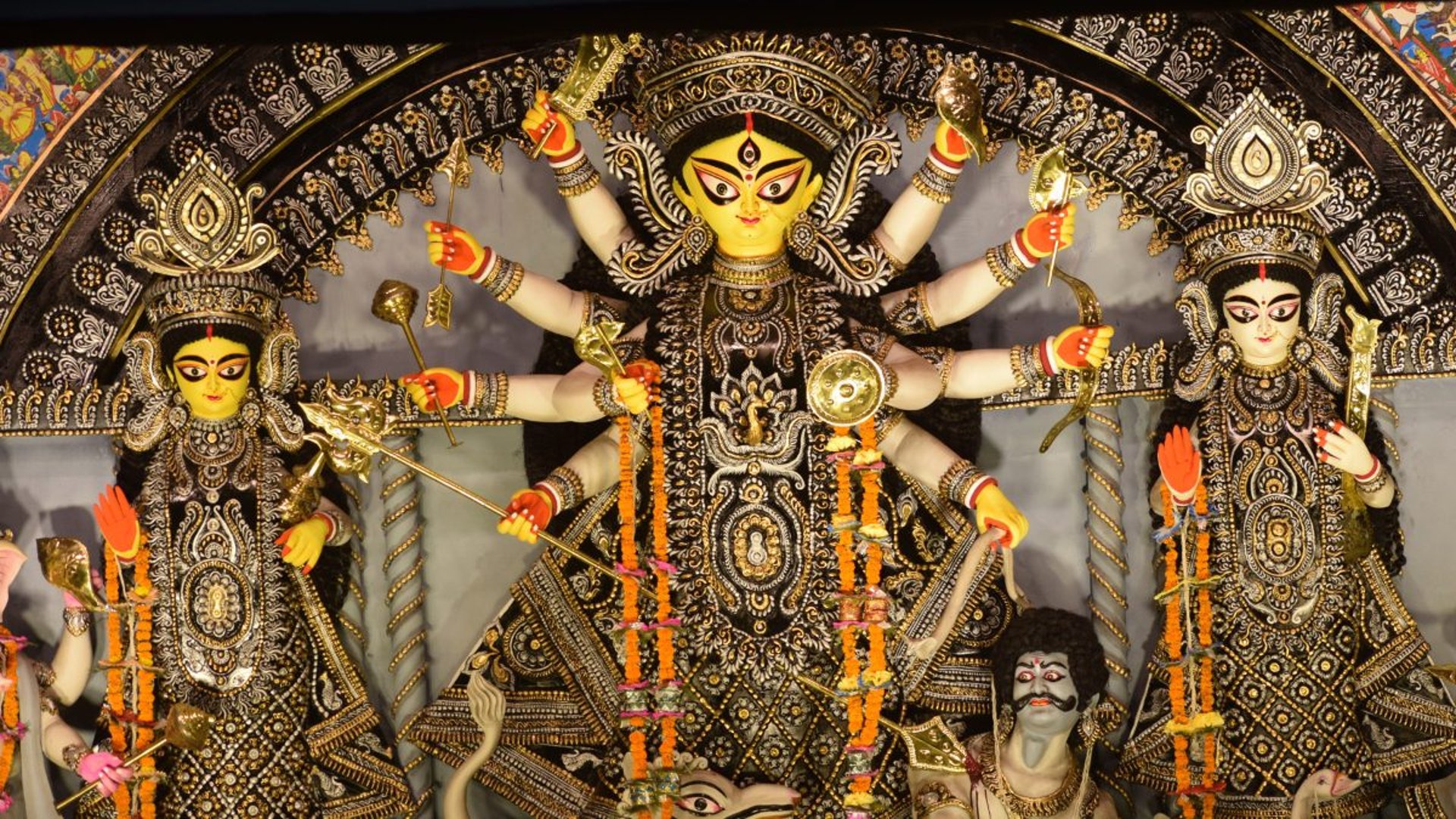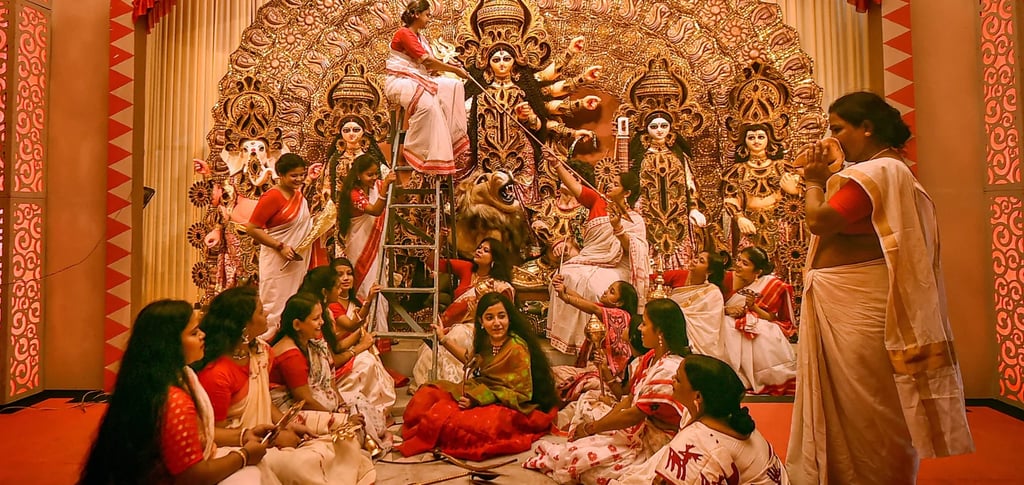Durga Puja 2025: Family Puja vs Pandal Celebration - Complete Guide to Dates & Traditions
Family courtyard or grand pandal - where does your heart find Maa Durga? There's something magical about both...Family worship preserves ancient traditions. Community celebrations spread the joy to all. One whispers, one roars. Both reach the same Mother's heart.



When is Durga Puja 2025 starting date? The most awaited Bengali festival begins on September 21st and continues until October 2nd, 2025. Whether you're planning a traditional family puja vs pandal celebration, this comprehensive guide covers everything you need to know about Durga Puja 2025 dates and the sacred choice between intimate home worship and grand community festivities.
Durga Puja 2025 Dates: Complete Schedule and Timing
Durga Puja 2025 will be celebrated from September 21st to October 2nd, with the main five-day celebration falling during the final phase of the festival.
Essential Durga Puja 2025 Dates Schedule:
· Festival Start: September 21, 2025 (Mahalaya)
· Shasthi: September 28, 2025 (Maa Durga's arrival)
· MahaSaptami: September 29, 2025 (First day of main worship)
· MahaAshtami: September 30, 2025 (Most auspicious day)
· MahaNavami: October 1, 2025 (Continued celebrations)
· Bijaya Dashami: October 2, 2025 (Farewell day)
Understanding these Durga Puja 2025 dates is crucial whether you're organizing a family celebration or planning your pandal hopping adventure.
Family Puja vs Pandal Celebration: Understanding the Sacred Choice
The beauty of Durga Puja 2025 lies in offering devotees two distinctly meaningful ways to connect with Maa Durga. The eternal question remains: family puja vs pandal celebration - where does your heart find the divine mother?
Family Puja: Where Tradition Whispers
Family puja vs pandal celebration debates often overlook the profound intimacy of home worship. In family courtyards across Bengal, Durga Puja 2025 takes on a deeply personal dimension that commercial pandals simply cannot replicate.
The Sacred Elements of Family Durga Puja:
Ancestral Prayer Books: Weathered manuscripts passed down through generations
Traditional Brass Diyas: The same lamps lit faithfully for decades
Garden Flowers: Marigolds and jasmine picked with loving hands
Children's Learning: Sanskrit mantras taught by grandparents
Family Recipes: Secret bhog preparations known only to the household
Intimate Conversations: Prayers that feel like talking to a beloved family member
Pandal Celebration: Where Community Roars
The family puja vs pandal celebration comparison reveals how community festivities create an entirely different spiritual energy. Durga Puja 2025 pandals transform neighborhoods into temporary temples where hundreds of hearts beat as one.
The Magnificent World of Pandal Celebrations:
Artistic Masterpieces: Themed decorations addressing contemporary social issues
Dhak Beats: Traditional drums that penetrate souls and unite spirits
Cultural Programs: Music, dance, and theatrical performances throughout the day
Community Kitchens: Free meals served to thousands, embodying unity
Strangers Becoming Family: Social barriers dissolving in shared devotion
Photography Paradise: Instagram-worthy artistic installations
Why Both Are Sacred: Resolving Family Puja vs Pandal Celebration
Durga Puja 2025 doesn't require you to choose between family intimacy and community celebration. Understanding why both approaches are sacred helps devotees appreciate the complete spiritual spectrum of the festival.
Family Puja Preserves Heritage
Generational Continuity: From Sasthi to Bijoya Dasami, families lovingly uphold age-old customs passed down through generations. These home rituals act like living bridges between ancestors and descendants, keeping the sacred thread of heritage unbroken.
Personal Connection: In the quiet sanctity of a home altar, devotees experience Maa Durga as a nurturing mother figure, not just a deity. Offering flowers on Mahasaptami or lighting lamps on Mahanabami becomes a deeply personal act of love and surrender.
Cultural Education: Children grow up watching the intricacies of Mahaasthami’s Anjali or the symbolic Sindoor Khela on Bijoya Dasami, learning not just how to perform them, but why they matter. This hands-on learning builds cultural identity and pride.
Emotional Intimacy: The air at home is filled with the fragrance of incense, conch shells echoing softly through familiar walls. These sensory moments bind the family together in prayer, making every chant and offering feel personal and heartfelt.
Customized Worship: Unlike standardized community rituals, family pujas allow space for personal nuances—special bhog recipes, ancestral chants, or family-specific timings—that make worship uniquely meaningful.
Pandal Celebrations Spread Joy
Democratic Participation: Public pandals welcome everyone, transcending social and economic boundaries. From Mahasaptami’s Pran Pratistha to Bijoya Dasami’s immersion procession, people from all walks of life come together as one collective family under Maa Durga’s gaze.
Artistic Evolution: Every year, pandals transform into magical worlds—mythology meeting modernity. Mahaasthami’s Sandhi Puja glows under dazzling lights, while Mahanabami sees choreographed dhunuchi dances swirling in clouds of incense, merging faith with visual spectacle.
Community Bonding: Neighbours become collaborators, planning months in advance, sharing responsibilities, decorating pandals, and cooking together. These joint efforts create lifelong friendships and a strong community spirit.
Cultural Exchange: Visitors from across regions come to witness authentic Bengali traditions—chanting the Chandi Path, ringing bells during Pushpanjali, and marvelling at the craftsmanship of idols and pandals. This becomes a cultural classroom without walls.
Social Impact: Many pandals use their grand platforms to raise awareness about pressing issues—environmental conservation, gender equality, mental health—infusing Mahanabami processions with messages of collective responsibility and hope.
Conclusion: Embracing the Complete Durga Puja 2025 Experience
The family puja vs pandal celebration question doesn't require a definitive answer. Durga Puja 2025, celebrating from September 21st to October 2nd, offers devotees the beautiful opportunity to experience both intimate family worship and grand community festivities.
Whether you find Maa Durga in the whispered prayers of your family courtyard, where grandmother's 60-year-old prayer book holds decades of devotion, or in the roaring celebrations of grand pandals, where dhak beats unite hundreds of hearts, both paths lead to the same divine destination.
The magic of Durga Puja 2025 lies not in choosing between these sacred spaces, but in understanding that both preserve different yet equally important aspects of our rich cultural heritage. Family pujas teach us about roots, intimacy, and personal spiritual connection. Pandal celebrations show us community strength, artistic evolution, and collective joy.
As millions prepare for this magnificent festival, remember that Maa Durga's presence transcends the physical space of worship. She resides equally in the clay idol of your family courtyard and in the artistic masterpiece of the community pandal. She hears both the whispered mantras of intimate family prayer and the synchronized chants of community celebration.
Plan your Durga Puja 2025 experience by honoring both traditions. Let the Durga Puja 2025 dates from September 21st to October 2nd be a time when you discover the divine feminine energy in every form - whether through ancestral family rituals or vibrant community celebrations. Maa Durga awaits to bless you through every prayer, in every sacred space where her devotees gather with love and devotion.
